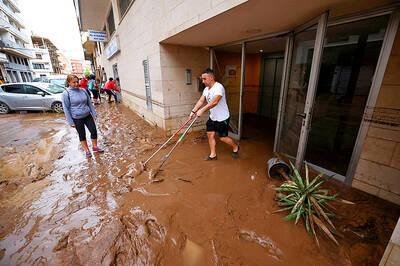It was three metres long, it weighed 700kg and it grazed on the lush banks of a South American river eight million years ago.
Phoberomys pattersoni, alias Goya the giant guinea pig, is the biggest rodent ever found, according to the journal Science yesterday.
In May 2000 researchers began recovering the fossilized bones from a layer of shale in what is now a hot desert region of Venezuela called Urumaco, 402km west of Caracas.
Only when they found the jaw did they realize that they had found a rodent ten times bigger than any on earth today.
And only when they had taken a closer look at the almost complete skeleton did they realize they had a caviomorph, cousin to the modern cavy or guinea pig. The bones were found at Tio Gregorio -- and the Spanish diminutive for Gregorio is Goya.
"Imagine a weird guinea pig, with a long tail for balancing on its hind legs and continuously growing teeth," said Marcelo Sanchez-Villagra of the University of Tubingen in Germany.
"It was semi-aquatic, like the capybara, and probably foraged along a riverbank."
There are around 5,000 species of mammal on the planet today. Around 2,000 of them are rodents. The smallest weighs a few grams, the largest, the capybara, a few tens of kilograms.
The unearthing of a species at least 10 times bigger than all the rest raises huge questions about the pace and direction of evolution -- and economies of scale.
"This really is a stunning animal," said McNeill Alexander of the University of Leeds, an expert on the mechanics of animals.
"If you saw this animal at a distance on a misty day it would look much more like a cow or a buffalo than like a guinea pig. Supporting its weight is no problem.
"How about feeding itself? It would not be very easy to satisfy its appetite, because it is big. It has teeth which are obviously used for grinding abrasive food -- grass."
Like a cow, the giant guinea pig would have depended upon micro-organisms in its gut to turn grass into nourishment.
The bigger an animal's gut, the faster the supply of energy from the fermenting grass. But also, the bigger the animal, the more it conserves energy and the less it needs to eat.
Other rodents have not grown to this sort of size because they tend to run down boltholes to get away from predators, which is why it helps to be small. They cannot outrun their enemies in the open.
The implication is that Phoberomys had relatively few enemies at the time.
The Panamanian landbridge formed only three million years ago.
Until then, South America was separated from the northern continent, and Phoberomys lived in a very different world.
It would probably have been at home on dry land and in the water, and it lived alongside catfish, turtles with a carapace two metres long, and predators that included a giant flightless, carnivorous bird, a marsupial cat the size of a lion and crocodiles more than nine metres long.

Police in China detained dozens of pastors of one of its largest underground churches over the weekend, a church spokesperson and relatives said, in the biggest crackdown on Christians since 2018. The detentions, which come amid renewed China-US tensions after Beijing dramatically expanded rare earth export controls last week, drew condemnation from US Secretary of State Marco Rubio, who on Sunday called for the immediate release of the pastors. Pastor Jin Mingri (金明日), founder of Zion Church, an unofficial “house church” not sanctioned by the Chinese government, was detained at his home in the southern city of Beihai on Friday evening, said

Floods on Sunday trapped people in vehicles and homes in Spain as torrential rain drenched the northeastern Catalonia region, a day after downpours unleashed travel chaos on the Mediterranean island of Ibiza. Local media shared videos of roaring torrents of brown water tearing through streets and submerging vehicles. National weather agency AEMET decreed the highest red alert in the province of Tarragona, warning of 180mm of rain in 12 hours in the Ebro River delta. Catalan fire service spokesman Oriol Corbella told reporters people had been caught by surprise, with people trapped “inside vehicles, in buildings, on ground floors.” Santa Barbara Mayor Josep Lluis

The Venezuelan government on Monday said that it would close its embassies in Norway and Australia, and open new ones in Burkina Faso and Zimbabwe in a restructuring of its foreign service, after weeks of growing tensions with the US. The closures are part of the “strategic reassignation of resources,” Venezueland President Nicolas Maduro’s government said in a statement, adding that consular services to Venezuelans in Norway and Australia would be provided by diplomatic missions, with details to be shared in the coming days. The Norwegian Ministry of Foreign Affairs said that it had received notice of the embassy closure, but no

A missing fingertip offers a clue to Mako Nishimura’s criminal past as one of Japan’s few female yakuza, but after clawing her way out of the underworld, she now spends her days helping other retired gangsters reintegrate into society. The multibillion-dollar yakuza organized crime network has long ruled over Japan’s drug rings, illicit gambling dens and sex trade. In the past few years, the empire has started to crumble as members have dwindled and laws targeting mafia are tightened. An intensifying police crackdown has shrunk yakuza forces nationwide, with their numbers dipping below 20,000 last year for the first time since records